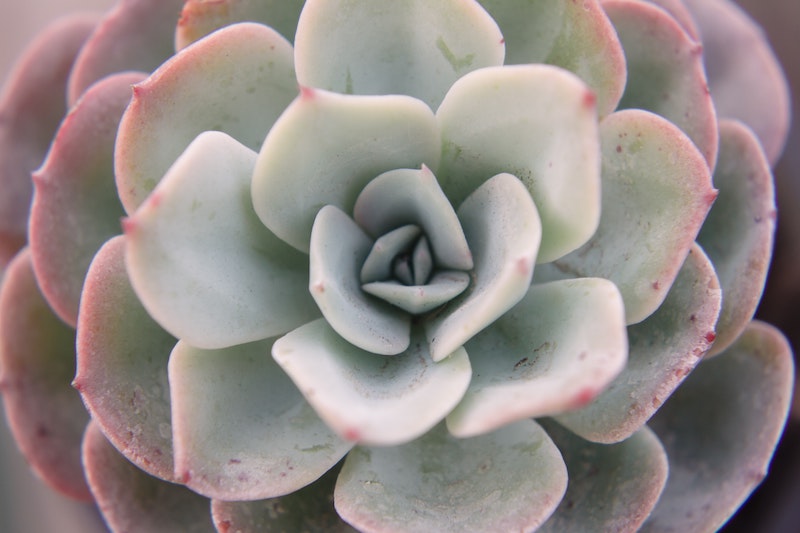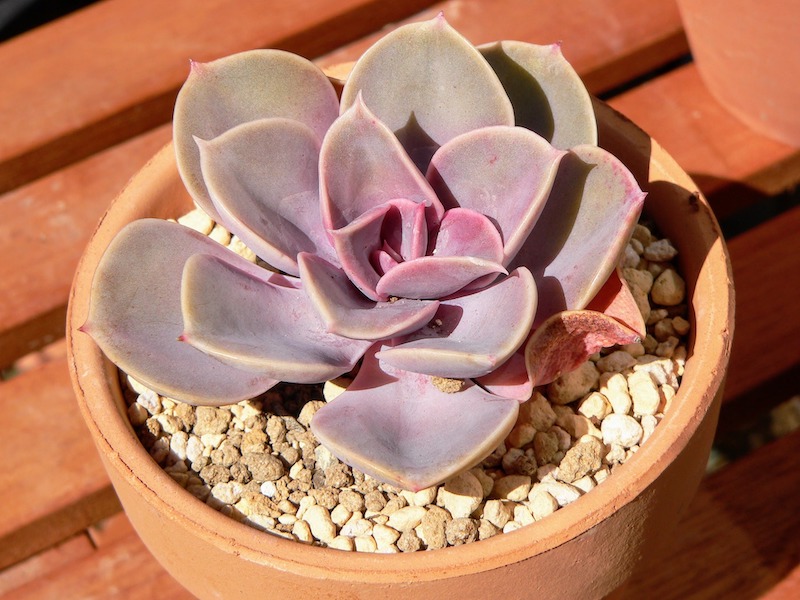Growing Echeveria
Echeveria is a genus of plants in the Crassulaceae family, beloved for their basal rosettes of thick, fleshy leaves arranged in perfectly geometric patterns. Native to desert regions of North, Central, and South America, echeveria is slow growing, rarely exceeding a foot in height or diameter. These plants produce tall, graceful spikes of peach or yellow flowers that can nearly double the plant’s height when blooming.
A large selection of species and cultivars are available. Their colorful leaves can be rounded or pointed, ranging from hues of dusty green-blue to shades of pink, purple and red. Taking care of echeveria is easy and rewarding for beginners and experienced growers alike.

Echeveria Sunlight Requirements
Echeveria needs bright indirect to bright direct light. Place your echeveria near a south- or west-facing window, where it will receive the most sunlight. It is important that echeveria gets at least 4-6 hours of sunlight per day; anything less than this will lead to weak, elongated growth as the plants search for light. Etiolated (stretched) echeverias are prone to leaning and breakage, and may lose their color due to lack of chlorophyll from insufficient light. Echeverias are also less likely to bloom if they are situated in low light environments. Be sure that your echeveria does not receive too much direct afternoon sun without proper acclimation, as this could cause sunburn on the leaves.
Planting Echeveria
Echeveria requires soil that is well drained and somewhat acidic. Choose a commercially available cacti potting mix, or make your own using a standard peat-based mix with equal parts sand and perlite. Select a pot that is about a half inch to an inch wider than the rosette of leaves. Only pot or transplant your echeveria when the soil is completely dry, and refrain from watering immediately after potting. This helps to prevent root rot from overwatering and transplant shock. Repot your echeveria every 2-3 years when it has outgrown its current pot.

Watering Echeveria
As succulents, echeverias have specialized cells that store water, which helps them survive in their native desert environment. Water your echeveria whenever the soil is completely dry. A good method of watering echeveria is to water it until liquid starts to flow from the pot’s drainage holes. Empty the water from the drainage tray, as standing water can lead to rot and attract pests. Allow your plant to completely dry out in between watering.
Echeveria will generally need to be watered every 7-12 days in the spring and summer months, and about once per month in fall through winter. Wrinkled, dry leaves are the primary symptom of underwatering, while mushy, brown, or leaking leaves and stems are a sign of rot from overwatering. Avoid placing your echeveria in a location with high humidity, such as a bathroom, as this can contribute to rot.
Fertilizing Echeveria
Regular fertilization is not necessary for echeveria. These plants have evolved in nutrient-poor soils, and are susceptible to leaf tip burn from excessive nutrients. If desired, echeverias can be fertilized just once per year during the active growth season of early spring. Choose a low-strength fertilizer formulated for succulents. A well-balanced, slow-release fertilizer diluted to a half or third strength works too.
Common Echeveria Problems
Root rot from overwatering is the most common cause of death in echeveria. If you notice signs of root rot, try to propagate the plant from healthy leaves or above the rotted stem. Yellowing or browning leaves are also usually caused by problems with watering. Be sure to check the soil and adjust your irrigation schedule. Occasionally, the lower leaves of echeveria may turn brown and dry. This is normal, as the older, lower leaves die back to divert energy towards fresh new growth. Echeverias that are leggy and etiolated cannot be fixed back to their original form; propagate them from leaf cuttings and grow in bright light.
Echeverias are susceptible to common houseplant pests, such as fungus gnats, spider mites, scale, and mealybugs. Use a horticultural oil on the stems, leaves, and leaf undersides to get rid of these pests. Diatomaceous earth or biological controls work well for fungus gnat larvae. Echeveria may also be prone to fungal disease from overwatering or high humidity. Treat with a household-safe fungicide and remove any infected leaves.
Propagating Echeveria
Echeverias can be easily propagated from stem or leaf cuttings. Using your fingers or scissors, cut off several healthy leaves or stems from the main plant. Place them in a dry location to callus over for several days. Next, place the cuttings in a tray of slightly moistened cacti mix. Eventually, a tiny rosette will form at the base of the leaf cuttings. Do not remove the shriveling leaf from the little rosette, as it is important for providing energy to the new plant. Often, echeveria will produce offshoots at the base of the mother plant. These offshoots can be propagated using the stem and leaf cutting method above. Rarely, echeverias can be propagated from seed. Barely cover the seeds evenly across a tray of well-drained potting mix. Keep the soil consistently moist under bright indirect light, and expect germination in several weeks.

Growing Echeveria Outdoors
Echeveria is hardy in USDA zones 9-12. In colder regions, it can be moved outdoors through the summer months, as it enjoys temperatures between 60-80°F. Move your echeveria inside whenever there is danger of frost, as it may lead to death or damage from cell expansion. Outdoor echeverias should be watered about once per week, and more often during hot, dry spells. Acclimate your indoor echeveria to outdoor sunlight by exposing it to direct sunlight for a few hours a day, gradually increasing exposure as time goes on. Examine your plant for any signs of pests when it is time to move it back inside.
 |
Lauren Youngcourt - Published 03-01-2023 |
